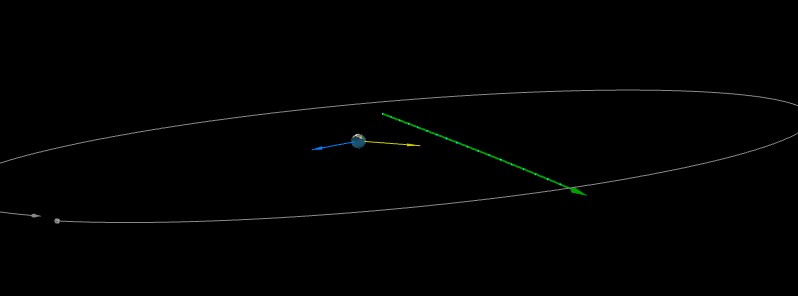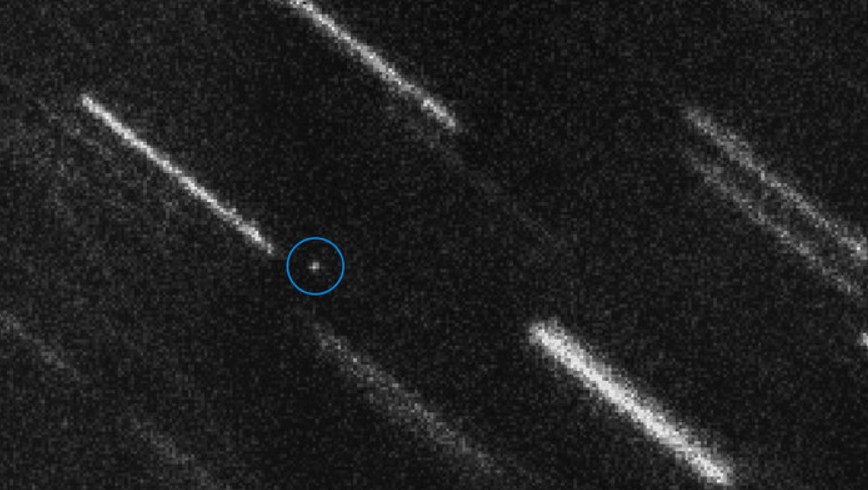New observations of near-Earth asteroid 2012 TC4 reveal 0.1 LD flyby

New observations of near-Earth asteroid designated 2012 TC4 reveal it will fly past our planet at a very close distance of 0.13 LD (~50 100 km / 31 140 miles) at 05:42 UTC October 12, 2017. Current estimates suggest it should peak around mag 13 at closest approach. At the time of closest approach, 2012 TC4 will be over a point in the ocean south of Australia.
The asteroid was spotted recently for the first time since its discovery in 2012. The original observations revealed the asteroid’s next approach to our vicinity would be in October 2017 but its orbit meant that it could not be tracked during the last five years, leaving astronomers unsure on how close it would come, ESA reported.
Owing to the latest VLT observations by O. Hainaut, D. Koschny, and M. Micheli, 2012 TC4 is now recovered, the 2012 TC4 Observing Campaign announced August 6. The campaign is part of a larger international initiative led by NASA and an excellent opportunity to test the international ability to detect and track near-Earth objects and assess our ability to respond together to a real asteroid threat.

Asteroid 2012 TC4 recovered in July/August 2017. Credit: ESO / ESA NEOCC / O. Hainaut (ESO), M. Micheli (ESA) & D. Koschny (ESA), CC BY-SA 3.0 IGO
Initial observations of a potential object found on July 27, 2017 were confirmed on July 31 and August 5, 2017. The JPL small database browser now posts the close approach distance for October 12 as 0.000335 AU (0.13 LD, ~50 100 km, 31 140 miles) based on the addition of M. Micheli's and O. Hainaut's astrometric measurements, and the object's H-magnitude value near 26.7, corresponding to a diameter of around 15 meters for an object with an albedo of about 15%.
Observing conditions (for observations at visible wavelengths)
- Conditions are fairly good for the asteroid's approach
- Near opposition
- Earth-facing surface is mostly illuminated
- Visible for many (6+) hours per night, for months before close approach
- Its orbit is within 1° of the ecliptic, so it is observable from both hemispheres.
- Within ~12 hrs of close approach, conditions change rapidly
- Declination† decreases from -9° (@-12 hrs) to -46° (@close approach) then rises again to +6 deg (@+12 hr).
- Solar elongation† decreases from 138° (@-12 hr) to 53° (@close approach) to a minimum at 16° (@+5 hr) and then slowly rises again to 39° (@+12 hr).
- Brightness increases rapidly, peaking shortly before close approach, then even more rapidly drops to become very faint.
- Radio and IR studies, which may be able to observe during the day, may be more successful in post-close approach time period than visible wavelength observations.
- †The example values listed here are given relative to a geocentric observer, but because the close approach distance is small, the specific geometric conditions will be strongly dependent on the observers actual location.
- Locations for observing around closest approach
- At the time of closest approach, 2012 TC4 will be over a point in the ocean south of Australia. Unfortunately, this occurs several hours before local sunset, so Australia is a poor location for observing any part of the closest approach phase of the encounter.
- Because the south Pacific extends to the East of the close approach point, there are no large ground-based telescopes that will be able to observe the asteroid at close approach when the Sun is below the horizon. However, there should be significant coverage when the asteroid is at its brightest shortly before closest approach.
- South America is likely to offer the best geometric conditions for ground-based observing. Although the asteroid will set shortly before closest approach, South America offers the longest baseline for observations leading up to the event.
- Mauna Kea is well positioned for observing the approach and peak brightness, but the asteroid never rises above an altitude of 26° and the sun rises and the asteroid sets before closest approach.
- The U.S. southwest is well positioned for observing the lead-in to closest approach, though the asteroid never rises above an altitude of 27° and sets before closest approach.
- Conditions are very poor for the asteroid's departure
- After close approach, the solar elongation is small
- Earth-facing surface is mostly in shadow
- Brightness drops very quickly
Size comparable to the Chelyabinsk event of February 2013
An asteroid of this size entering our atmosphere would have a similar effect to the Chelyabinsk event.
That asteroid exploded some 29.7 km (18.5 miles) above Russian city of Chelyabinsk at 09:20 YEKT (03:20 UTC) on February 15, 2013, damaging over 3 000 buildings and injuring over 1 500 people (mostly by broken window glass), had an estimated size of approximately 20 m (65 feet). Its light was brighter than the Sun, visible up to 100 km (62 miles) away.
Chelyabinsk asteroid, officially named Chelyabinsk meteorite, was undetected before its atmospheric entry, in part because its radiant was close to the Sun.

Check your speakers. Loud asteroid explosion on video.
In the hours following the visual meteor sighting, a 6-metre (20 feet) wide hole was discovered on Lake Chebarkul's frozen surface and scientists from the Ural Federal University collected 53 samples from around the hole the same day it was discovered.
A large number of small meteorites fell on areas west of Chelyabinsk and local residents and schoolchildren located and picked up some of them, many located in snowdrifts, by following a visible hole that had been left in the outer surface of the snow.


In June 2013, Russian scientists reported that further investigation by magnetic imaging below the location of the ice hole in Lake Chebarkul had identified a 60 cm (2 feet) wide meteorite buried in the mud at the bottom of the lake. Following an operation lasting a number of weeks, it was raised from the bottom on October 16, 2013. With a total mass of 654 kg (1 442 lb), this is the largest found fragment of the Chelyabinsk meteorite.
In November 2013, a video from a security camera was released showing the impact of the fragment at the Chebarkul Lake. From the measured time difference between the shadow generating meteor to the moment of impact, scientists calculated that this meteorite hit the ice at about 225 meters per second, 64 percent of the speed of sound.
This is the first recorded impact of a meteorite on video. You can see it below:


Video shows the first recorded impact of a meteorite. Chelyabinsk, Russia February 15, 2017
Reference:
Asteroid 2012 TC4 at Minor Planet Center, CNEOS
Featured image: The green line indicates the object's apparent motion relative to the Earth, and the bright green marks are the object's location at approximately one-hour intervals. The Moon's orbit is gray. The blue arrow points in the direction of Earth's motion and the yellow arrow points toward the Sun. Credit: Minor Planet Center

Commenting rules and guidelines
We value the thoughts and opinions of our readers and welcome healthy discussions on our website. In order to maintain a respectful and positive community, we ask that all commenters follow these rules.